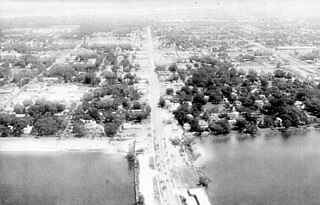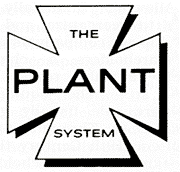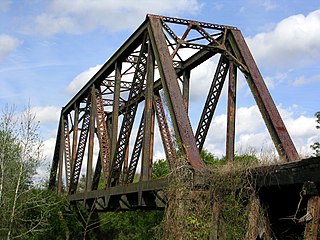
Palmetto is a city in Manatee County, Florida, United States. As of the 2020 census, the population was listed as 13,323, up from 12,606 at the 2010 census. It is part of the North Port–Bradenton–Sarasota, Florida Metropolitan Statistical Area.

The Seaboard Air Line Railroad, which styled itself as "The Route of Courteous Service", was an American railroad that existed from April 14, 1900, until July 1, 1967, when it merged with the Atlantic Coast Line Railroad, its longtime rival, to form the Seaboard Coast Line Railroad. Predecessor railroads dated from the 1830s and reorganized extensively to rebuild after the American Civil War. The company was headquartered in Norfolk, Virginia, until 1958, when its main offices were relocated to Richmond, Virginia. The Seaboard Air Line Railway Building in Norfolk's historic Freemason District still stands and has been converted into apartments.

The Seminole Gulf Railway is a short line freight and passenger excursion railroad headquartered in Fort Myers, Florida, that operates two former CSX Transportation railroad lines in Southwest Florida. The company's Fort Myers Division, which was previously the southernmost segment of CSX's Fort Myers Subdivision, runs from Arcadia south to North Naples via Punta Gorda, Fort Myers, Estero, and Bonita Springs. The company's other line, the Sarasota Division, runs from Oneco south through Sarasota. Seminole Gulf acquired the lines in November 1987 and operates its own equipment. The company's first train departed Fort Myers on November 14, 1987.

The Plant System, named after its owner, Henry B. Plant, was a system of railroads and steamboats in the U.S. South, taken over by the Atlantic Coast Line Railroad in 1902. The original line of the system was the Savannah, Florida and Western Railway, running across southern Georgia. The Plant Investment Company was formed in 1882 to lease and buy other railroads and expand the system. Other major lines incorporated into the system include the Savannah and Charleston Railroad and the Brunswick and Western Railroad.

Southwest Florida is the region along the southwest Gulf coast of the U.S. state of Florida. The area is known for its beaches, subtropical landscape, and winter resort economy.

The Bone Valley is a region of central Florida, encompassing portions of present-day Hardee, Hillsborough, Manatee, and Polk counties, in which phosphate is mined for use in the production of agricultural fertilizer. Florida currently contains the largest known deposits of phosphate in the United States.

Stretching 148 miles (238 km) across the Florida peninsula, State Road 70 spans five Florida counties and straddles the northern boundaries of two more. Its western terminus is at US 41 south of Bradenton ; its eastern terminus is an intersection of Virginia Avenue and South Fourth Street in Fort Pierce.

The Champion was a streamlined passenger train operated by the Atlantic Coast Line Railroad and Florida East Coast Railway between New York City and Miami or St. Petersburg, Florida. It operated from 1939 until 1979, continuing under the Seaboard Coast Line and Amtrak. It was a direct competitor to the Seaboard Air Line Railway's Silver Meteor, the first New York-Florida streamliner.
The Florida Southern Railway was a railway that operated in Florida in the late 1800s. It was one of Florida's three notable narrow gauge railways when it was built along with the South Florida Railway and the Orange Belt Railway. The Florida Southern was originally chartered to run from Lake City south through central Florida to Charlotte Harbor. However, with the influence of Henry B. Plant, it operated with two discontinuous segments that would be part of the Plant System, which would later become part of the Atlantic Coast Line Railway.
The Charlotte Harbor and Northern Railway is a historic railroad line that at its greatest extent serviced Gasparilla Island in Charlotte Harbor and a major shipping port that once operated there. The railroad's principal purpose was to transport phosphate mined along the Peace River and in the Bone Valley region of Central Florida to the port to be shipped. It also brought passengers to the island community of Boca Grande on Gasparilla Island, and is largely responsible for making Boca Grande the popular tourist destination it is today. Part of the line remains in service today between Mulberry and Arcadia, which is now owned and operated by CSX Transportation. Today, it makes up CSX's Achan Subdivision and part of their Brewster Subdivision.
The Tampa Southern Railroad was a subsidiary of the Atlantic Coast Line Railroad (ACL) originally running from Uceta Yard in Tampa south to Palmetto, Bradenton, and Sarasota with a later extension southeast to Fort Ogden in the Peace River valley built shortly after. It was one of many rail lines completed during the Florida land boom of the 1920s. Most of the remaining trackage now serves as CSX Transportation's Palmetto Subdivision. Another short portion just east of Sarasota also remains that is now operated by Seminole Gulf Railway.

The Palmetto Subdivision is a CSX Transportation rail line in the Tampa Bay region of Florida. It runs from just south of Tampa south to Bradenton.
The Brewster Subdivision is a railroad line owned by CSX Transportation in Florida. The line runs from the Valrico Subdivision at Edison Junction south through Bradley Junction to Arcadia for a total of 47.2 miles. It junctions with the Achan Subdivision and the Agricola Spur at Bradley Junction, and connects to the Seminole Gulf Railway in Arcadia.
CSX Transportation's Valrico Subdivision is a railroad line in Central Florida. It serves as CSX's main route through a region of Central Florida known as the Bone Valley, which contains the largest known deposits of phosphate in the United States.

The Atlantic Coast Line Railroad's Haines City Branch was a railroad line running from their main line in Haines City, Florida south through southern Central Florida. The line notably ran through Lake Wales, Avon Park, Sebring, and Immokalee and would stretch as far south as Everglades City upon its completion in 1928. Everglades City would be the southernmost point the entire Atlantic Coast Line Railroad system would ever reach. The Haines City Branch was one of the Atlantic Coast Line's major additions to its Florida network, much of which was previously part of the Plant System.
The Atlantic Coast Line Railroad's Lakeland—Fort Myers Line was one of the railroad company's secondary main lines in Central and Southwest Florida. It was built incrementally in the late 1800s and early 1900s. Parts of the line are still active today.

The Seaboard Air Line Railroad's Sarasota Subdivision was a rail line that ran from the company's main line at Turkey Creek south to Palmetto, Bradenton, Sarasota, and Venice. The line was built in phases from 1901 to 1911.
The Atlantic Coast Line Railroad's DuPont—Lakeland Line was a historic rail line in southern Georgia and the northern west coast of Florida. On employee timetables, the line was actually divided into the DuPont—High Springs Line and the High Springs—Lakeland Line. The line was primarily used for freight, though some passenger services ran on parts of it in Florida. While parts of the line were built as early as 1863, the full line was not complete until 1913. Parts of the line in Florida are still active today.












